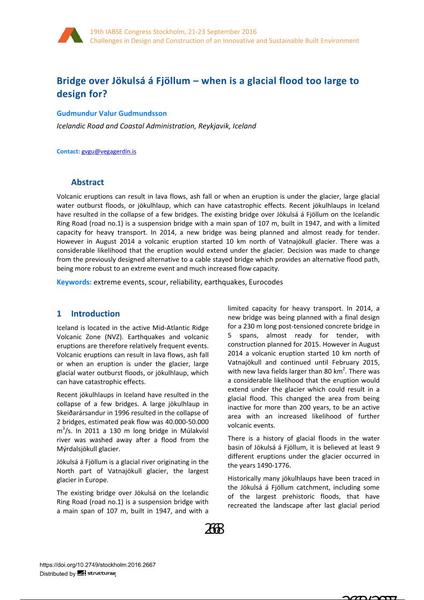Bridge over Jökulsá á Fjöllum – when is a glacial flood too large to design for?

|
|
|||||||||||
Détails bibliographiques
| Auteur(s): |
Gudmundur Valur Gudmundsson
(Icelandic Road and Coastal Administration, Reykjavik, Iceland)
|
||||
|---|---|---|---|---|---|
| Médium: | papier de conférence | ||||
| Langue(s): | anglais | ||||
| Conférence: | IABSE Congress: Challenges in Design and Construction of an Innovative and Sustainable Built Environment, Stockholm, Sweden, 21-23 September 2016 | ||||
| Publié dans: | IABSE Congress Stockholm, 2016 | ||||
|
|||||
| Page(s): | 2668-2675 | ||||
| Nombre total de pages (du PDF): | 8 | ||||
| Année: | 2016 | ||||
| DOI: | 10.2749/stockholm.2016.2667 | ||||
| Abstrait: |
Volcanic eruptions can result in lava flows, ash fall or when an eruption is under the glacier, large glacial water outburst floods, or jökulhlaup, which can have catastrophic effects. Recent jökulhlaups in Iceland have resulted in the collapse of a few bridges. The existing bridge over Jökulsá á Fjöllum on the Icelandic Ring Road (road no.1) is a suspension bridge with a main span of 107 m, built in 1947, and with a limited capacity for heavy transport. In 2014, a new bridge was being planned and almost ready for tender. However in August 2014 a volcanic eruption started 10 km north of Vatnajökull glacier. There was a considerable likelihood that the eruption would extend under the glacier. Decision was made to change from the previously designed alternative to a cable stayed bridge which provides an alternative flood path, being more robust to an extreme event and much increased flow capacity. |
||||
| Mots-clé: |
tremblements de terre
|
||||
